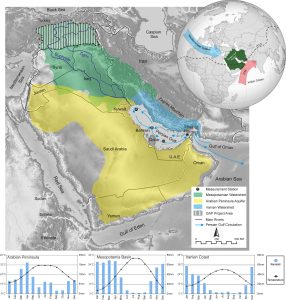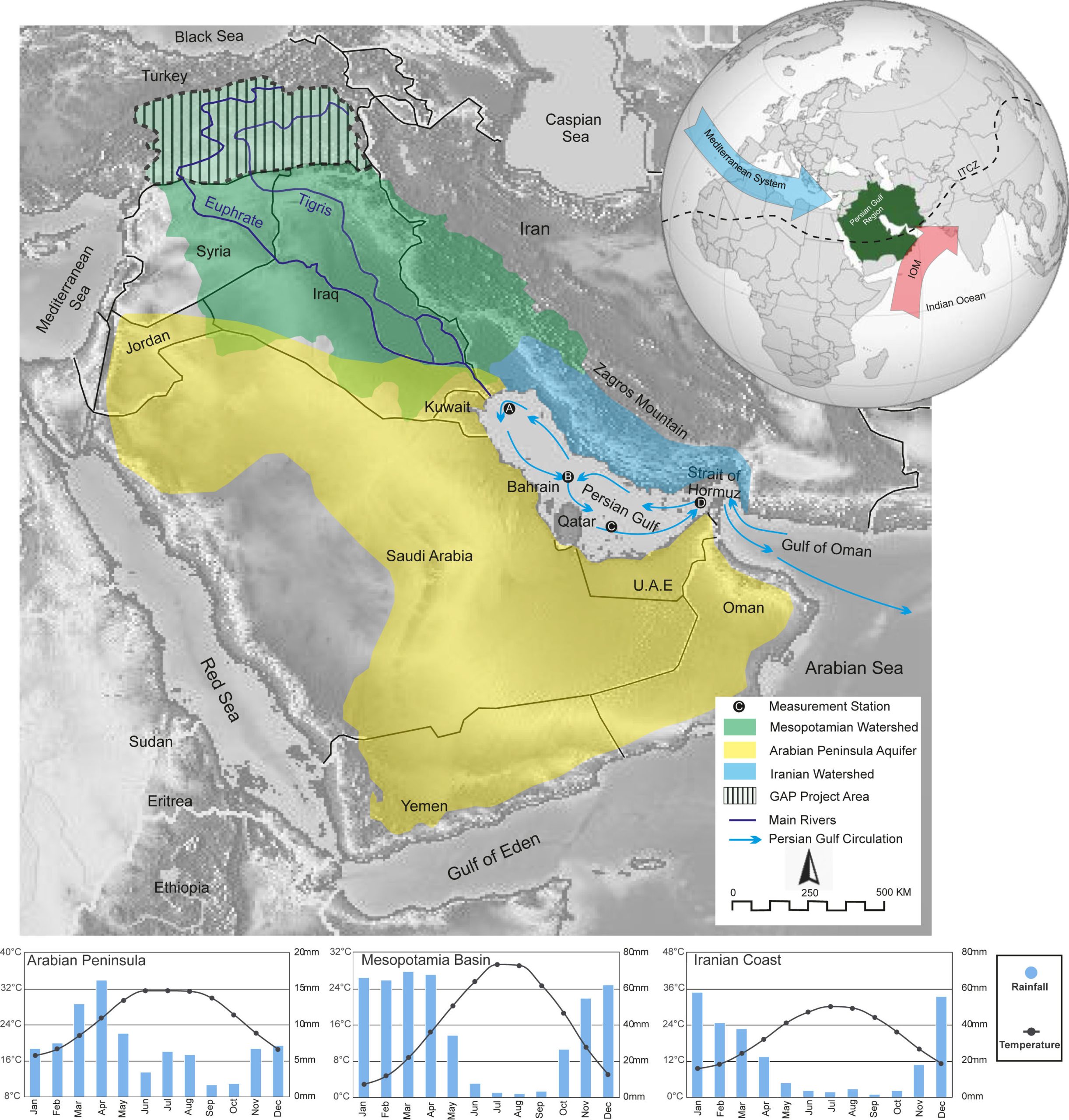Discover how climate change is transforming the Persian Gulf ecosystem. Explore rising temperatures, biodiversity loss, extreme weather, and regional adaptation strategies in this expert maritime guide.
Why Climate Change in the Persian Gulf Matters
The Persian Gulf is a shallow, enclosed sea surrounded by some of the fastest-developing nations on Earth. While it’s globally recognized for its oil exports and strategic maritime routes, it is also one of the world’s most climate-vulnerable marine ecosystems. In a region where summer temperatures regularly soar above 45°C on land and 35°C at sea, climate change is no longer a distant threat. It’s a lived reality.
The Gulf’s ecological balance is fragile: coral reefs, seagrass beds, mangroves, migratory bird sanctuaries, and vital fisheries coexist with dense shipping lanes, desalination plants, and coastal megacities. Today, this ecosystem is being pushed to its limits by rising sea temperatures, sea-level rise, acidification, and extreme weather events.
Understanding how climate change affects the Persian Gulf isn’t just for scientists. It’s essential for maritime professionals, fisheries, port authorities, urban planners, and students committed to building a sustainable future in one of the most stressed marine environments on Earth.

Climate change: A driver of future conflicts in the Persian Gulf Region?, Credit: https://www.cell.com/heliyon/fulltext/S2405-8440%2821%2900393-5
The Science Behind Climate Change in the Persian Gulf
The Persian Gulf is exceptionally shallow—averaging just 35–40 meters in depth—and nearly enclosed, with limited water exchange through the Strait of Hormuz. This makes it highly sensitive to even minor changes in atmospheric and oceanic conditions.
According to a 2023 review in the Journal of Marine Science and Engineering, the Gulf is warming nearly twice as fast as the global ocean average. Sea surface temperatures have increased by around 2°C since the 1980s, and projections suggest they could rise by another 1.5–3°C by 2100 if emissions remain high.
At the same time, the Gulf is experiencing:
-
Increased sea-level rise of 2.1–3.4 mm per year, accelerating coastal erosion and flooding risks.
-
Rising ocean acidity, with pH levels decreasing due to carbon dioxide absorption.
-
Intensified dust storms and extreme rainfall events, which alter coastal sedimentation and water quality.
These changes are not isolated—they interact with human-made stressors like desalination, overfishing, and port construction, compounding ecological degradation.
Key Ecological Impacts of Climate Change
Coral Reef Bleaching and Collapse
Coral reefs in the Persian Gulf are among the most thermally tolerant in the world. Yet even they have limits. The 2017 bleaching event caused widespread coral mortality across the UAE, Qatar, Bahrain, and Saudi Arabia’s coasts.
According to the Emirates Nature–WWF (2022), coral coverage in some areas has declined by up to 70% over the last three decades. Bleached reefs become algae-dominated rubble zones, reducing fish habitat and biodiversity.
Decline in Fish Stocks and Fisheries
Warming seas disrupt the reproductive cycles, migration routes, and habitat ranges of key fish species such as kingfish, grouper, and snapper. In recent years, fishers in Kuwait and Iran have reported shifting fish distributions, with some species migrating northward toward cooler waters.
Data from the FAO Regional Fisheries Committee for the Gulf indicate a 20–30% drop in annual fish catch per unit effort (CPUE) in certain coastal areas since 2000, driven in part by climate-induced changes.
Mangroves and Coastal Buffer Zones at Risk
Mangroves, particularly Avicennia marina, provide coastal protection and carbon sequestration. Rising sea levels and prolonged high temperatures stress mangrove root systems and alter salinity levels.
A 2021 study by The Royal Institution of Naval Architects reported that mangrove dieback is accelerating in areas like Ras Al Khaimah and Bushehr, reducing biodiversity and increasing vulnerability to storm surges.
Ocean Acidification and Plankton Loss
Plankton, the foundation of the marine food web, is also affected. Acidified waters inhibit calcium carbonate shell formation in planktonic species, impacting everything from bivalves to commercial fish.
Long-term monitoring by KAUST (King Abdullah University of Science and Technology) has shown a 10–15% decline in zooplankton biomass in the central Gulf since 2008, with cascading effects on higher trophic levels.
Case Studies: Climate Stress in Action
Dubai’s Coastline and Urban Flooding
The UAE has experienced record rainfall and flash flooding in 2022 and 2024, overwhelming stormwater systems and impacting port logistics. Combined with rising sea levels, this has led to saltwater intrusion into freshwater aquifers and increased coastal erosion, particularly in Dubai and Abu Dhabi.
To adapt, the UAE has begun implementing climate-resilient urban planning—elevated waterfront infrastructure, mangrove replanting, and climate impact zoning.
Kuwait Bay: Ecosystem Collapse Warning
Once a biodiversity hotspot, Kuwait Bay has witnessed massive fish kills in recent summers. Water temperatures have reached 36°C, creating hypoxic zones where oxygen levels plummet. A joint study by UNEP and Kuwait Environment Public Authority (KEPA) cited climate change, wastewater discharge, and algal blooms as contributors.
The area now serves as a “climate red flag zone,” where cumulative stressors are visibly pushing an ecosystem toward collapse.
Technology and Tools for Climate Adaptation
Smart Buoy Networks and Real-Time Monitoring
The UAE and Oman have deployed smart buoys equipped with sensors that monitor sea temperature, pH, oxygen, and turbidity. These buoys feed into national climate databases and support marine protected area (MPA) management and emergency planning.
Initiatives such as Inmarsat’s OceanIQ and Copernicus Marine Service provide satellite-based analytics for long-term trend analysis.
Coral Resilience and Assisted Evolution
Scientists at KAUST and New York University Abu Dhabi are experimenting with assisted coral evolution—selectively breeding or engineering thermally resilient coral strains that can survive Gulf conditions.
Pilot coral nurseries are also being developed off Ras Al Khaimah and Qatar, with some success in reef transplantation and post-bleaching recovery.
Maritime Emissions Reduction
Ports like Jebel Ali and Sohar are adopting shore power systems to reduce greenhouse gas emissions from berthed ships. The IMO’s GHG Strategy (2023) encourages such efforts, with funding support from UNDP and regional climate adaptation funds.
Challenges and Regional Gaps
Limited Regional Coordination
Climate change affects the entire Gulf, but national responses vary widely. While the UAE and Saudi Arabia have clear adaptation frameworks, others lag in monitoring, enforcement, or public communication.
A unified Persian Gulf Climate and Marine Strategy—similar to the EU’s Marine Strategy Framework Directive—is urgently needed, ideally coordinated through ROPME (Regional Organization for the Protection of the Marine Environment).
Data Transparency and Sharing
Much of the Gulf’s ecological data is fragmented or unpublished. Encouraging open-access science, cross-border data sharing, and regional research partnerships is critical.
Platforms like the Arab Climate and Environment Portal and the GCC Water and Climate Observatory are promising steps forward.
Future Outlook: Turning the Tide
Despite the sobering trends, there is cause for cautious optimism. Gulf nations are increasingly aware of their ecological vulnerabilities and economic dependence on marine resources.
By investing in resilience-building, coastal restoration, and decarbonization, the region can adapt to the climate challenge. Examples like the Abu Dhabi Blue Carbon Project—which quantifies carbon stored in seagrass and mangroves—show how natural ecosystems can be climate allies.
Climate-smart maritime education, green port certification, and community-led conservation are on the rise, especially among younger generations of professionals and students.
Frequently Asked Questions (FAQ)
Why is the Persian Gulf more vulnerable to climate change than other regions?
Its shallow depth, enclosed geography, and high salinity make it especially sensitive to warming, acidification, and sea-level rise.
Which marine species are most affected?
Corals, plankton, mangroves, and commercially valuable fish species like grouper and kingfish are among the hardest hit.
What role does shipping and desalination play?
Both contribute to environmental stress through emissions, thermal discharge, and habitat alteration. However, reforms are underway to green these sectors.
Are Gulf countries taking action?
Yes, though progress varies. The UAE, Saudi Arabia, and Oman have launched significant climate adaptation and marine monitoring programs.
Can the Persian Gulf recover from climate damage?
With concerted effort, some ecosystems—like mangroves and coral reefs—can recover. But time is critical. Delayed action risks irreversible damage.
Is climate change affecting port operations in the Gulf?
Yes. Rising sea levels, storms, and heatwaves are affecting port logistics, vessel routing, and coastal infrastructure stability.
What can maritime professionals do?
Stay informed, integrate environmental monitoring into operations, support carbon reduction measures, and advocate for policy change.
Conclusion
Climate change is not a future threat—it’s a present-day reality reshaping the Persian Gulf. Its warm waters, vital ecosystems, and coastal cities are on the frontlines of a global environmental crisis. But with smart technology, cooperative policy, and local engagement, the region can still adapt, recover, and thrive.
As maritime professionals, students, and global citizens, we each have a part to play. Whether you’re charting sea routes, designing ports, or simply learning about this remarkable region, your awareness is part of the solution.
The Persian Gulf’s future is still being written. Let it be a story of resilience, not retreat.

